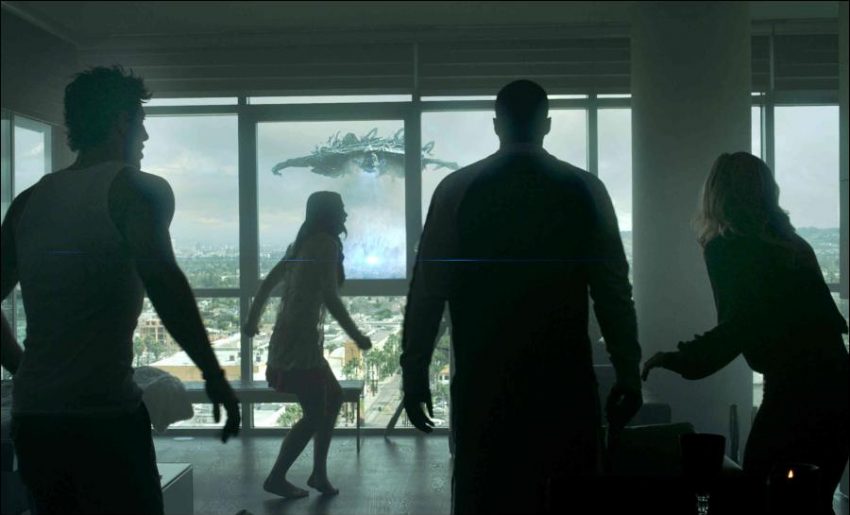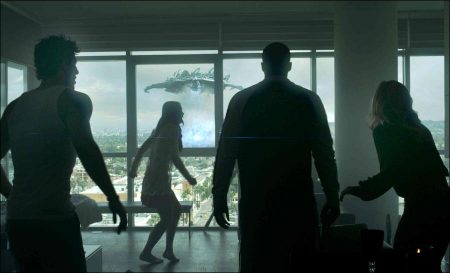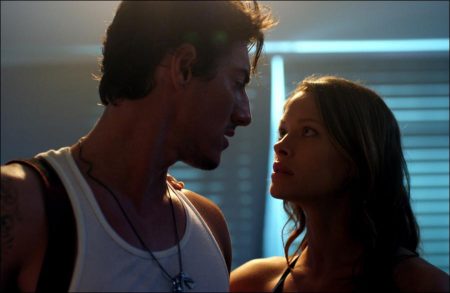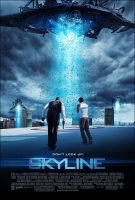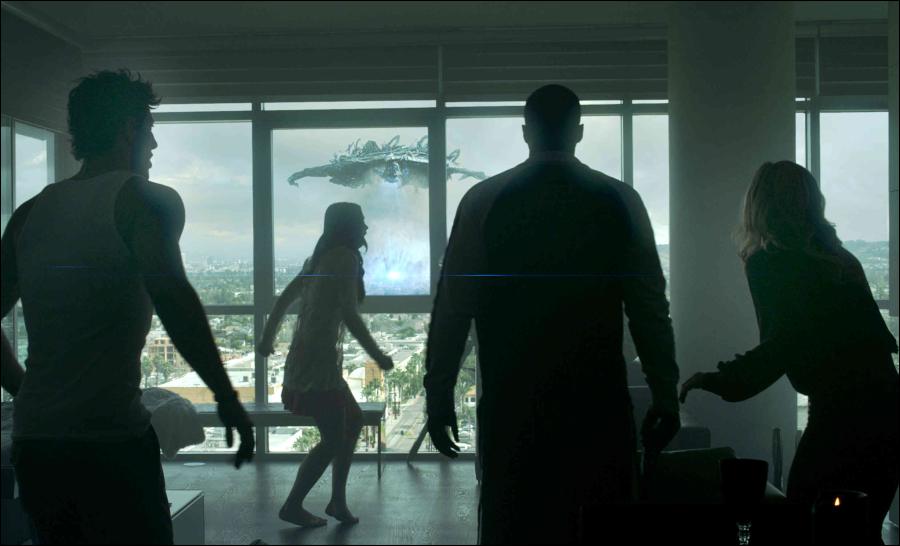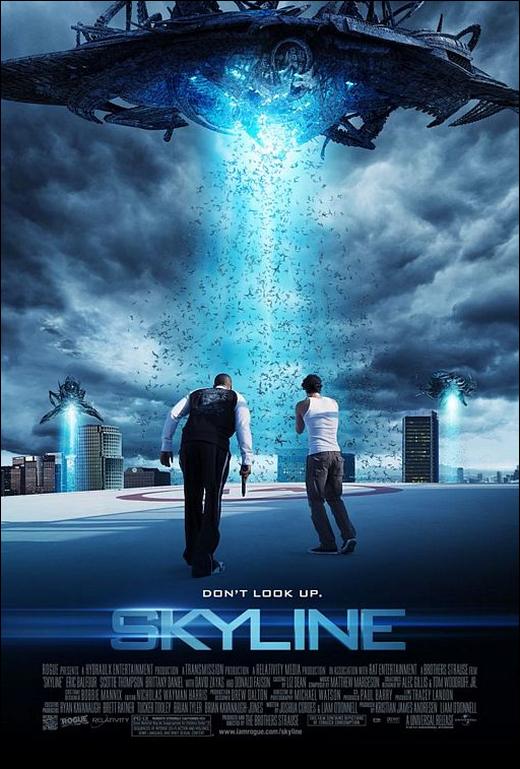All About Skyline
Greg Strause concurs: “One of the reasons we embarked upon Skyline was that in this day and age, movie budgets have become enormous. At the same time, movie studios have generally been cutting down the number of films they make. We were just at the boiling point. We said, ‘We’re going to shoot a movie ourselves.’ Skyline has gone from concept to release date in less than a year.”
As they were going it on their own, they knew they had to have an even tighter organization for the production than a big-budget picture would. “One of the things that made it so efficient was our ‘power structure,’ as we call it,” Greg Strause continues. “The committee, the multiheaded dragon, only had five heads: Liam, Josh, Kristian, Colin and myself. It was easy for us to all do a group huddle. We have almost a decade working together with Josh and over five years with Liam. We’ve known Kristian for about 10 years, and we all speak the same language.”
The tightly knit group they had assembled would make the casting, designing, shooting and editing of Skyline much more streamlined. It didn’t hurt that two siblings were helming the process. Explains Cordes: “Because you have co-directors and because they’re brothers, it allows for more collaboration.”
O’Donnell adds: “At the same time, they are businessmen; they know the financial implications of a day of shooting. They don’t frivolously shoot or go over budget or schedule to feed their egos.”
To prove that Skyline could be done on the budget and with the schedule they imagined, the production team put a teaser trailer together in a one-day shoot and acquired the necessary financing for a full film (and international presales) at the Berlin International Film Festival in February 2010. Explains Greg Strause: “We told our investors, ‘Well here you go! That was a one-day shoot, so check out this teaser.’ Everyone was sold and believed we could do it. We were off to the races.”
When they were developing Skyline, the Brothers Strause and writers O’Donnell and Cordes were committed to having a character-driven movie. Knowing that tropes of many sci-fi screenplays include enormous visuals and disposable characters, they vowed to avoid the obvious traps. “We wanted the characters to be the main point of the movie that this huge visual world is wrapped around,” shares Colin Strause. “One of the fun things was creating moments of pure terror as our characters watch this event unfold. But then all of a sudden, the cast finds themselves right in the middle of these huge set pieces.”
As the script centered on Jarrod and Elaine, the Brothers Strause wanted to bring the audience to the crossroads where this young couple has found itself. Offers O’Donnell: “The main character, Jarrod, has a metamorphosis from an overgrown boy into a father, a protector. The theme of fatherhood interests us; both Colin and I are fathers. The moment you find out that you’re going to be a dad is a really intense, lifechanging experience that we felt hadn’t been tackled this way in many films.”
Greg Strause explains who they imagined the character to be: “We meet Jarrod, and he’s around 30 years old. He’s coming to terms with adulthood—time to stop being a boy and grow into being a man. There’s also a fish-out-of-water story with Jarrod and Elaine coming from out of town. There’s nothing worse than being in a crisis situation in a strange land. You don’t have this home-field advantage playing for you. He made his ascent to this lap of luxury at Terry’s during a catastrophe.”
To portray the role of the first character cast, they selected Eric Balfour. Commends Andresen: “Everybody knew that Eric Balfour was our Jarrod. After he read for the part, we were sold that he should be the guy that the audience wants to help save his family.”
Selected as Elaine, Jarrod’s girlfriend who is suspicious of the actual reason that they are visiting Jarrod’s old friend in Los Angeles, was Scottie Thompson. Though the young actress had landed many supporting roles, Skyline would prove her first lead. Notes producer O’Donnell of Thompson’s selection: “Scottie was the wild card. She came in and did this amazing read. We never called her back for anything; she was perfect.”
Chosen as Jarrod’s best friend, special-effects wizard Terry, was an actor much more well known for his comic roles than his dramatic choices: Donald Faison. Cordes offers that Faison took the casting quite seriously and showed a side of his talents they’d never seen. He says: “Donald is a huge science fiction fan and always wanted to fight aliens. We would recite Star Wars dialogue to each other on set. When the cameras rolled, he slipped into action hero mode.”
The screenwriters actually penned the role of Oliver, the building’s concierge, for Dexter’s David Zayas. Recalls Andresen: “We didn’t even audition him, it was just an offer. We were thrilled that he agreed to come onto the project.”
Another performer primarily known for her comic work was brought onto the production to play Terry’s self-absorbed socialite girlfriend. Brittany Daniel was asked to join Skyline as Candice. O’Donnell recalls her casting: “Brittany has the same manager as Donald. She came over to read the script after Donald was cast. She loved the character, and we loved her.”
Rounding out the core cast of the production were two other young performers: actress CRYSTAL REED as Terry’s assistant, Denise, and NEIL HOPKINS as Ray. Hopkins is most well known as the heroin-addicted Liam from the juggernaut series Lost. As the bulk of Skyline was shot in one location, there were not the luxuries that a typical big-budget film set would offer. Colin Strause explains: “We didn’t have trailers. We literally had another condo in the building. Everyone hung out together. Our cast hung out with the crew, and we all spent time in the same living room. It wasn’t like you had to grab all these people from their separate little camps.”
Acting opposite stunt performers who served as stand-ins for the attacking aliens was a challenge for the cast, to stay the least. It was a treat for them all to be shown clips of the film before their panel at San Diego’s Comic-Con in July 2010. Recounts Andresen: “None of the talent had seen any of the footage until San Diego. Faison freaked out the night before Comic-Con. Then I showed the rest of them when we were about to go on for our panel and everybody was blown away, saying, ‘Are you kidding me?’”
One archetype the audience won’t find in Skyline is the nebbish genius who walks the audience through the aliens’ rationale. Laughs Colin Strause: “We didn’t want any scientists or anyone to explain what was happening in the film. You always get that moment in a movie when you ask, ‘How’d that guy know that?’ We thought, ‘What if you have this regular group of people instead?’ It becomes more interesting because you wonder how the aliens do what they do and what makes our group of humans unravel.”
While the brothers had to be unerringly strict with certain aspects of production, they had many luxuries of which other shoots can only dream. That included having people they know and trust serve in multiple capacities on the project. Though Joshua Cordes co-wrote the script, he also served as second-unit director, pre- and post-VFX animator and occasional camera operator. Kristian Andresen was not only producer of the sci-fi thriller, but also worked as first assistant director and location manager. As well, co-writer O’Donnell served as script supervisor for the 42-day shoot.
This was enormously helpful as the team designed and shot Skyline with the multitalented production designer Drew Dalton and DP Michael Watson. “How many movies have writers on set every single day of the shoot?” Colin Strause asks. “How many times is the writer also the camera guy…so he knows why he’s pointing the camera at the big, empty sky? It saved us a lot of communication because Josh and Liam wrote a scene, we previsualized everything out in the computer with my 1980s-style video-game animatics and blocked out all the scenes. Since everyone was there every day, there was never an instance when we had to phone someone and ask them a question.”
Joshua Cordes explains: “By pre-vising what the monsters were going to do, I knew when Jarrod would be moving a certain way. When I had a camera in my hand, I could see the tentacle whipping around and stabbing his leg. So when I got the timing just right, I whipped it around. If you have that natural camera movement, it makes the final effect that much more convincing; it’s like a camera operator is following something that’s there.”
While many sci-fi thrillers are set and shot at night to compensate for any issues with the inevitable CGI, it was important to the brothers to showcase the terror during the day. They felt confident their work on dozens of big-budget films had prepared them to pull it off. States Colin Strause: “We combined the scale of an event movie with the action of an invasion film. Having people watch as dozens of motherships are sucking up millions of people off the face of the Earth…that’s something you have to see during the day. At nighttime, that wouldn’t look like much. In the daytime, there’s a constant reminder that there’s nowhere else you can go.”
O’Donnell also appreciated that they were able to shoot outside during the day. He notes: “You don’t need it to rain and for it to be nighttime to be scary. Daylight exteriors can be your best friend because you can move so fast and you can get so much done. Our big pool chase only took half a day.”
As the production didn’t follow a typical script to pre-vis to shooting to postproduction trajectory, the team needed to be very flexible as they created Skyline. Form would always follow function. Greg Strause offers: “We wanted to do a big event movie in a smaller budget range and go very cinematic with the visuals. That comes from a camera operating standpoint as well as a lighting standpoint. When we were developing the script, there was a bit of the cart drawing the horse. Here’s the location: we’re shooting in my condo. Here’s the garage in the building: we have access to that. We had the pool, an elevator; we had the ingredients that our budget would allow. It was about pushing Josh and Liam to be as smart as possible to utilize these spaces so that they still served the most important aspect of the film: the story.”
When deciding upon the best method to meld the live-action performances with the aliens’ attacking the City of Angels, the brothers decided that they didn’t want to use green screens to re-create the action. Rather, they chose to rely on the specificity of their lightweight RED cameras to film everything. According to Colin Strause: “One of the big things we’ve encountered with using green screen is that it’s usually a weird crutch. It should only be used in extreme situations. It feels artificial because you often shoot your foregrounds but don’t get the same lighting on your backgrounds. Everything feels out of sync.”
In order to make the action look realistic, the team shot all the interactions between the actors and stunt players (who served as points of reference) on camera. That way, the actors could punch, knock down or get knocked down by the “aliens” without the DP, camera crew and directors fussing over the green screen’s placement. Greg Strause elaborates: “In order to have green-screen coverage everywhere, you can’t physically put the lights you want to create the fill light for an exterior; that’s because the green screen is there. So now you’re trapped. Doing something that was the most cost-effective allowed us to get shots that looked better and cost a lot less to create in post.”
More complex rigging and stunts also benefitted from this logical choice to shoot complex sequences entirely in camera. One of the more intricate sequences stunt coordinator MARK NORBY choreographed was something few in Los Angeles—not to mention in the Marina del Rey complex—had ever seen. Colin Strause shares: “We built this giant wire rig on the helicopter pad of the building, pulling actors up into the air and shooting the whole thing in camera with fans blowing. We actually had the real sun setting in the background as the actors were being hoisted up. The shots just look beautiful, and you’d never get that on a green screen.”
Skyline (2010)
Directed by: Colin Strause, Greg Strause
Starring by: Eric Balfour, Scottie Thompson, Brittany Daniel, Crystal Reed, Neil Hopkins, Tanya Newbould, Phet Mahathongdy, Donald Faison, Tanya Newbould, Robin Gammell, Tony Black
Screenplay by: Joshua Cordes
Production Design by: Drew Dalton
Cinematography by: Michael Watson
Film Editing by: Nicholas Wayman-Harris
Costume Design by: Bobbie Mannix
Music by: Matthew Margeson
MPAA Rating: PG-13 for sequences of intense sci-fi action and violence, some language, and brief sexual content.
Distributed by: Rogue Pictures
Release Date: November 12, 2010
